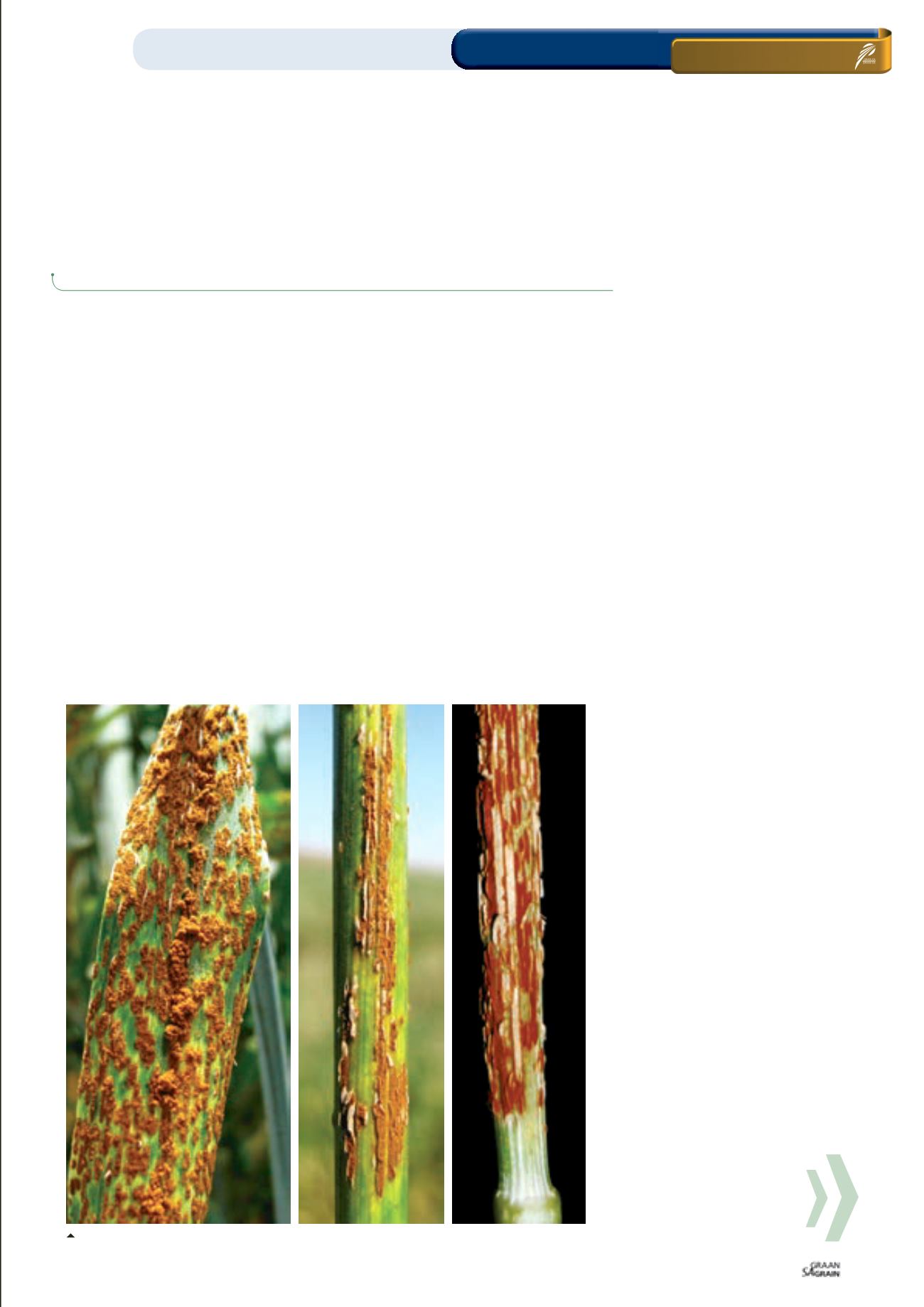
Variants of stem rust raceUg99
detected inSouthAfrica
S
tem rust is an economically im-
portant disease of bread wheat
worldwide. This disease mainly
infects the stem of wheat (
Photo 1
)
and it could cause up to 100% yield loss in
highly susceptible cultivars.
Significant stem rust epidemics have been
recorded inmanycountries, includingSouth
Africa. Although resistant cultivars provide
effective stem rust control, resistance is
often short-lived as new races frequently
develop and infect previously resistant
cultivars.
For instance, a highly virulent new race,
Ug99, was discovered in Uganda, East
Africa in1999.Ug99differed frompreceding
races mainly by its virulence against the
resistancegene
Sr31
(Pretorius
et al
., 2000).
Prior to 1999,
Sr31
had remained effective
formore than30yearsandhence ithasbeen
widely used in resistance breeding inmany
countries. Most wheat breeding lines and
cultivarsgrownaround theworldat the time
of theUg99discoverycarried
Sr31
andwere
therefore susceptible to this race. Given
its potential to spread worldwide, Ug99 is
considered a serious threat to global wheat
production and food security.
Following the detection of Ug99, several
related races were found which indicated
that Ug99 had evolved and overcame
additional resistance genes. In 2006, a
variant of Ug99 with virulence against
Sr24
was identified, and in 2007, Ug99 evolved
again and became virulent against
Sr36
. To
date, eight closely related races which are
commonly considered as Ug99 variants
havebeen identified. Four of theeight Ug99
variants have been confirmed in South
Africa (
Figure 1
). These are 2SA88 (TTKSF,
North American race notation), 2SA106
(TTKSP), 2SA107 (PTKST) and 2SA88+
(TTKSF+).
Race2SA88was firstdetected in theWestern
Cape in 2000 and has since dominated the
stem rust race population in South Africa.
The widespread occurrence of 2SA88 is
thought tobedue to its virulenceon several
resistance genes and the cultivation of
susceptible cultivars, in particular in the
WesternCapewhere favourableweather for
stem rust development exists. Race 2SA88
isnot virulent against resistancegenes
Sr24
and
Sr31
.
Race 2SA106 (virulent against
Sr24
) was
first detected in 2007 and its frequency
significantly increased in 2008 and 2009,
but declined in the next season. As
Sr24
waswidelyused inSouthAfrica as a source
of resistance, 2SA106 has been closely
monitored by the surveillance team at the
ARC-Small Grain Institute (ARC-SGI).
However, no significant stem rust epide-
mics have been observed following the
discovery of 2SA106, probably due to the
fact that commercialwheatproducers in the
Western Cape routinely apply fungicides
to control rusts and other wheat diseases.
Race 2SA106 was last detected in South
Africa in 2010.
Race 2SA107 (virulent against
Sr24
and
Sr31
) was first identified in South Africa
in 2009 in two disease nurseries near
Cedara and Greytown. In 2010, it was also
detected in experimental plots near Reitz
(Free State) andWinterton (KwaZulu-Natal),
thereby spreading to additional wheat
growing areas.
A large number of South African spring
wheat cultivars and lines tested since
2010 were susceptible to 2SA107 (Pretorius
et al
., 2012). Thiscouldmakewheat cultivars
grown in areas like the Western Cape,
vulnerable to stem rust infection. To date,
2SA107 has however not been observed in
theWestern Cape. Fortunately, most winter
wheat varieties are resistant to the Ug99
racegroup, including 2SA107.
Race 2SA88+was first detected at Afrikas-
kop, in the Free State, in 2010, but it hasn’t
been detected anywhere since then, except
in 2013 when it was found in samples
collected from Tygerhoek in the Western
Cape. This race is similar to 2SA88, except
for its virulenceon theMatlabas cultivar.
91
August 2014
ON FARM LEVEL
Pest control
Stem rust /Disease / Breadwheat / Resistance
TAREKEGN TEREFE,
ARC-Small Grain Institute and
ZAKKIE PRETORIUS,
University of the Free State
Photo 1: Stem rust symptoms on a leaf and stems ofwheat.


